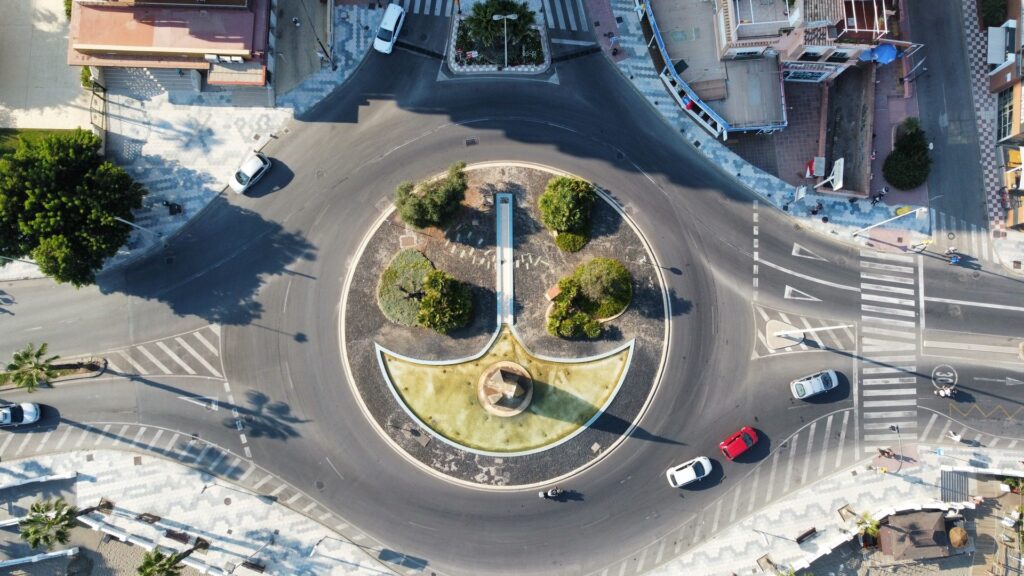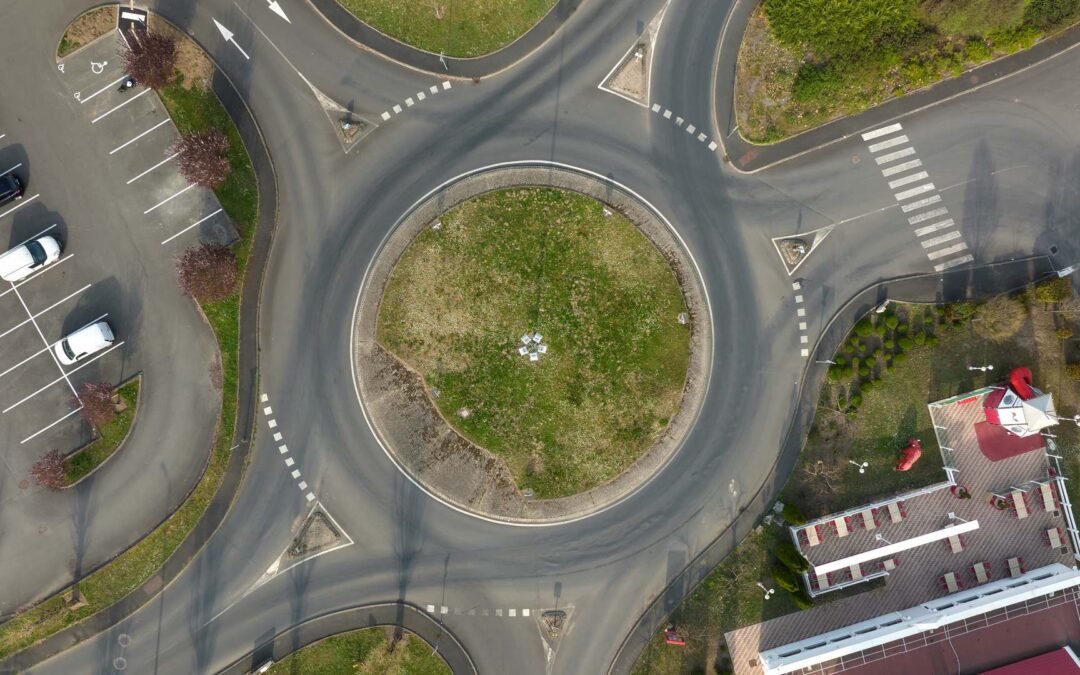Roundabouts are designed to improve traffic flow and reduce the likelihood of accidents. However, accidents can still occur, particularly in areas like Georgia where drivers might be less familiar with navigating these traffic features. Understanding the steps to take if you’re involved in a roundabout accident in Georgia is crucial for your safety, legal protection, and insurance claims.
Understanding Roundabouts in Georgia
A roundabout is a circular intersection where drivers travel counterclockwise around a central island. The primary purposes of roundabouts include reducing traffic speeds, minimizing severe crashes, and improving traffic flow. Unlike traditional intersections, roundabouts eliminate the need for traffic signals and reduce the points at which vehicles can collide.
Prevalence of Roundabouts in Georgia
In recent years, Georgia has increased the number of roundabouts throughout the state. The Georgia Department of Transportation (GDOT) supports the use of roundabouts due to their safety benefits and efficiency in handling traffic.
Steps to Follow Immediately After an Accident in a Roundabout
1. Ensure Safety
First and foremost, ensure your safety and the safety of others. Your immediate action should focus on assessing your physical condition and that of your passengers and other parties involved. If there are no serious injuries, it’s crucial to move vehicles out of the roundabout if safe to do so. This action helps to prevent additional accidents caused by the obstruction of traffic flow and minimizes the risk to stationary vehicles and pedestrians. If the vehicles cannot be moved, turn on hazard lights to alert incoming drivers to the hazard ahead. Always prioritize personal safety against oncoming traffic when exiting your vehicle.
2. Notify the Authorities
Even in minor accidents, it’s important to notify the police. Contacting law enforcement is a critical step, as a police report provides an official record of the incident. This report is a valuable document for dealing with insurance claims and can be essential in legal situations, particularly when there are disputes about the accident. When you call the police, be precise about your location using road names or landmarks; this is particularly important in a roundabout where multiple exits and entries must be clearly identified. Stay at the scene until the police have arrived and you have spoken to the officer in charge.
3. Exchange Information
It’s critical to exchange information with all drivers involved in the accident. This step is not just a legal formality; it’s a practical necessity for resolving the consequences of the accident. Collect as much information as possible, including driver and vehicle details, as well as insurance information. Be methodical in collecting this information and ensure accuracy, as errors can complicate later claims or disputes. Additionally, if there are any witnesses who saw the accident, their accounts can be invaluable, so gathering their contact information can be crucial for further clarification of the event.
4. Document the Scene
Taking the time to document the scene thoroughly can significantly aid in your insurance claim and any potential legal proceedings. Use your smartphone or camera to take clear pictures from various angles, capturing the overall context of the accident and specific damage to all vehicles involved. If you possess a dashcam, ensure the footage before, during, and after the accident is saved and backed up. Such documentation can provide definitive proof of circumstances and help clarify the dynamics of the accident, which can be particularly complex in roundabouts.
5. Do Not Admit Fault
The moments following an accident can be confusing and stressful, which might lead one to inadvertently admit fault. It is crucial to remain neutral, sticking to the facts without expressing opinions or assumptions about the incident. Discussions about the accident should be limited to factual information exchanges and should not include conjecture about who was at fault or the causes of the accident. Admitting fault at the scene can complicate your legal and insurance proceedings and may inaccurately reflect the dynamics of the accident.

Legal Considerations in Georgia
Understanding Fault in Georgia
Georgia’s approach to handling fault in vehicle accidents follows the “modified comparative fault” model. This framework is pivotal for anyone involved in a roundabout accident as it directly influences how damages are assessed and compensated. In practical terms, this means that you can still seek recovery for damages if you are partially at fault for the accident, provided your level of responsibility is determined to be less than 50%. For example, if it is determined that you are 30% at fault in an accident, you can still recover 70% of your total damages from the other parties involved. This system underscores the importance of a thorough and accurate assessment of the accident to determine the degree of fault correctly, as it directly affects the compensation you might receive.
Legal Requirements for Reporting Accidents
Under Georgia law, the criteria for when an accident must be reported are quite specific. Any accident that results in death, injuries, or property damage exceeding $500 must be reported to the appropriate authorities, which can include the local police, the county sheriff, or the state patrol. This legal requirement ensures that there is an official record of the incident, which is crucial for the adjudication of fault and the processing of insurance claims. Reporting the accident also facilitates the involvement of law enforcement to assess the scene, which can help in determining the specifics of the accident more accurately, including the potential fault of involved parties.
Role of Legal Counsel
Engaging a qualified personal injury attorney can be crucial after being involved in a roundabout accident, particularly under certain circumstances. If the accident results in significant vehicle damage, physical injuries, or even fatalities, legal representation can help protect your rights and ensure a fair evaluation of the incident. Additionally, if there is a dispute over who is at fault — a common scenario in accidents involving multiple vehicles or ambiguous circumstances — a skilled lawyer can be invaluable in navigating the complexities of the legal arguments. Lastly, if the settlement offered by your insurance company does not adequately cover the damages or losses incurred, a lawyer specializing in traffic accidents can negotiate on your behalf or pursue further legal action to obtain a fair resolution.
Dealing with Insurance After a Roundabout Accident
Prompt action is crucial after a roundabout accident when it comes to dealing with your insurance company. The first step is to file an insurance claim as soon as possible. This means contacting your insurance provider to inform them of the incident and providing them with a comprehensive dossier of information collected at the scene. This information should include the police report, photos of the accident, witness statements, and any other documentation that can substantiate your claim. The details you provide will form the basis of your insurance claim and are essential for a thorough evaluation by your insurer. Prompt reporting not only ensures that the details are fresh but also helps to expedite the claims process, which can be beneficial in resolving the situation and getting the necessary repairs started.
Understanding Insurance Investigation
Once your claim is filed, your insurance company will conduct an investigation to ascertain the specifics of the accident. This investigation aims to determine who was at fault, what coverage is applicable, and the amount of compensation that should be offered based on the policy terms. During this process, you may be asked to provide additional information or clarification on certain aspects of the incident. It’s crucial to cooperate fully and provide truthful, accurate information. The insurer’s assessment will directly affect how much and when you will be compensated for your losses. Understanding that this investigation is a standard procedure designed to protect all parties involved can make the process less daunting.
Negotiating Settlements
After the investigation, your insurance company will likely extend a settlement offer. This offer is meant to cover the costs of repairs, medical expenses, and any other losses you’ve incurred as a result of the accident. It’s essential to critically assess whether the proposed settlement adequately compensates you for your actual damages and losses. If the offer seems insufficient, or if it does not adequately cover all the damages or costs incurred, you are not obligated to accept it immediately. In such cases, negotiation is a key step. You can either negotiate directly with your insurance adjuster or seek legal advice to help in these negotiations. An attorney who is experienced in handling auto accident claims can provide significant leverage in securing a fair settlement. If negotiations with the insurance company stall, or if the offer is still not satisfactory, legal action may be necessary to obtain a just compensation.
Preventative Measures for Future Safety
Proper education on how to navigate roundabouts is crucial in minimizing accidents and enhancing road safety. Drivers should be familiar with the unique rules and signs that govern roundabouts. For example, it’s essential to know that vehicles inside the roundabout have the right of way and that drivers should always yield to traffic already circulating. Understanding these principles can significantly reduce the chances of collisions. Additionally, practicing defensive driving techniques can make a significant difference. Defensive driving includes being aware of your surroundings, anticipating potential hazards, maintaining a safe following distance, and being prepared to react calmly and effectively to unexpected situations.
Vehicle Maintenance
A well-maintained vehicle is less likely to malfunction and cause an accident. Regular maintenance checks are vital, especially focusing on vehicle components that are crucial for safe driving. Ensuring that your brakes are responsive and in good working order can prevent accidents, especially in situations requiring sudden stopping within a roundabout. Tire maintenance is equally important; properly inflated tires with good tread depth improve vehicle handling and reduce stopping distances. Regular checks and maintenance of vehicle lights ensure that other drivers can see your vehicle in poor visibility conditions and understand your intentions, especially when signaling to exit a roundabout. These preventive maintenance practices not only extend the lifespan of your vehicle but also enhance safety by reducing the likelihood of breakdowns or malfunctions that could lead to serious accidents in a roundabout setting.
Conclusion
Being involved in a roundabout accident in Georgia can be a stressful experience. By following the outlined steps—from ensuring safety and legality to dealing with insurance—you can manage the situation more effectively. Always prioritize safety, seek professional advice when necessary, and advocate for your rights within the legal and insurance frameworks.

